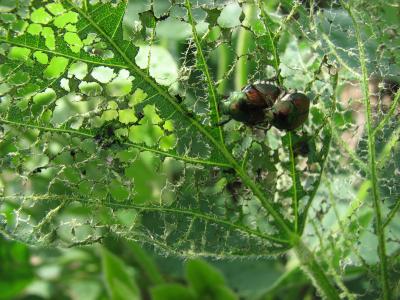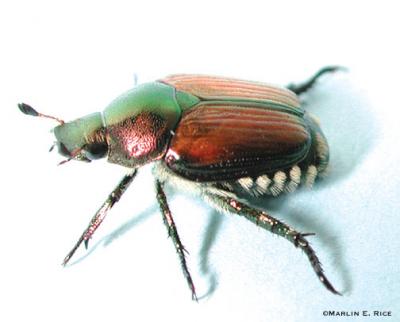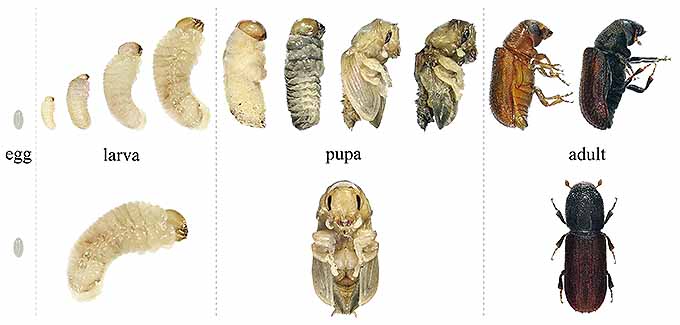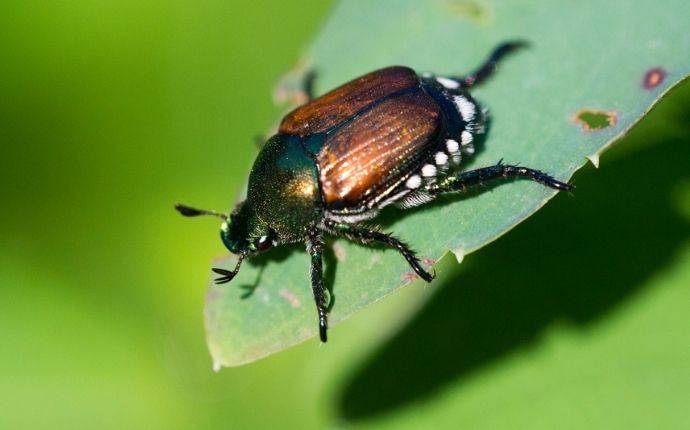japanese beetle life cycle iowa
Larvae live in the soil where they feed on plant. By Donald Lewis Department of Entomology.
Extension Outreach Crop Sciences Department College Of Aces University Of Illinois
Monitoring and Control Monitoring.

. One generation per year. Thats because much of its life cycle takes place underground. Both as adults and as grubs the larval stage Japanese beetles are destructive plant pests.
Japanese beetle larvae are annual white grubs. Appearance of adult the timing of oviposition and subsequent development have been shown to vary with latitude altitude and also from year to year Fleming 1972. Japanese beetle larva underground.
Japanese beetles eat more than 300 types of vegetation. In late autumn the grubs burrow 48 inches into the soil and remain inactive all winter. Japanese beetle has one generationyear.
Life Cycle In most parts of its range the Japanese beetle completes its life cycle in one year but some populations in cooler climates may complete their development in two years Vittum 1986. Its not easy to spot the Japanese beetle at first. Japanese beetle larvae are destructive to turfgrass roots and have limited mobility in the soil and adults feed mainly between leaf veins.
Japanese beetles that were present last summer laid eggs in moist soil covered with grasses turfgrass waterways. Japanese beetles are often found in field edges or areas of delayed growth. Japanese beetle life cycle Adult female beetles lay eggs in the soil in early June.
Many but not all beautiful insects are good for crops. As soil temperatures warm in the spring the larvae move closer to the soil surface. In Iowa adult beetles emerge in mid-June through July.
Corn soybean ornamentals fruit trees grapes weeds. Adults feed on the foliage and fruits of several hundred species of fruit trees ornamental trees shrubs vines and field and vegetable crops. After the egg hatches in summer the grub feeds on roots until the following summer when it emerges as a shiny beetle.
Japanese beetle larvae overwinter as third instars 10 to 15 cm deep moving down in the soil to avoid freezing. Life cycle of Japanese beetles. Here are the stages in the lifecycle of a Japanese beetle.
This is when grubs are present in the top inch of the root zone heavily feeding on grass roots and thatch. The eggs hatch into white grubs in ten days to two weeks or longer depend- ing on soil temperature. That is it takes one year to complete the development and growth from egg to adult and there is only one generation per year.
The grubs are C-shaped and approximately 125 inches when fully grown. Adults emerge from grass in late June and immediately begin to feed on low-lying plants such as roses and shrubs. However most of the damage to ornamentals and turf grass happens during the spring and fall the second year.
Adults begin emergence around 1030 degree days. They overwinter as third instar larvae in the soil below the frost line. The eggs hatch in about 2 weeks and the developing Japanese beetle larvae white grubs feed on organic matter and grass roots until late fall.
In the spring as the soil warms up the larvae move closer to the surface and begin feeding on roots. Growing degree days accumulated base 50F for Japanese beetle adults in Iowa 1 January-14 June 2015. Life Cycle Japanese beetles have one generation per year in Iowa Photo 1.
Some of the most common trees to suffer dieback from the Japanese Beetle in Des Moines Iowa are the River birch Betula nigra Paper birch Betula papyrifera Linden or American basswood Tilia americana and fruit trees. A typical cluster of Japanese beetle eggs. Adult females lay eggs in moist sod in July.
Observing Japanese beetles feeding on plants is quite common since the adult beetle feeds on about 300 species of trees shrubs ornamental and fruit trees in addition to vegetable crops. Orkin Termite Treatment Pest Control Exterminator Service. The Japanese beetle adult an attractive pest.
Larvae pupate in June and adults emerge about two weeks later to start the life cycle again. The immature stage of the Japanese beetle the white grub typically has a three year life cycle. In most parts of its range the Japanese beetle completes its life-cycle in one year but some populations in cooler climates may complete their development in two years Vittum 1986.
This insect is an invasive pest that can feed on corn and soybean plants. While the adult life cycle of the Japanese Beetle is over at the end of the growing season it is always a good time to look ahead. By late August these grubs are almost full size and will spend the next 10 months in the soil.
This insect spends about 10 months a year in the ground in the larval stage. A distinguishing feature of the beetles is five tufts of white hairs on each side of the abdomen. Japanese beetles have a univoltine life cycle one generation per year.
The head and thorax are shiny metallic green and the wing covers are coppery red. The larvae feed on roots of grass and other plants close to the surface of the soil. Japanese beetle life cycle.
The Japanese beetle Popillia japonica has an annual life cycle. The adult Japanese beetle lives above- ground for about 2 summer months and spends about 10 months under- ground. Japanese Beetle Life Cycle When Japanese beetles emerge from the ground in late June they burrow 2-3 inches in the ground and begin laying eggs.
Each of the first two larval instars stages requires a feeding period of about three weeks. The egg larva and pupa life cycle stages develop underground and unless soil is removed or dug into these life stages will not be seen. Japanese beetles are similar to other Junebugs in appearance and 38 inch long and 14 inch wide.
The appearance of adults the timing of oviposition and subsequent development have been shown to vary with latitude and altitude and also from year to year Fleming 1972. The significance of this invasive species in the Midwestern United States is increasing with first detection in Iowa in 1994. Well established east of the Mississippi River the Japanese beetle is also present in most other corn and soybean growing states.

How To Get Rid Of Japanese Beetles In Your Yard

Japanese Beetle Pests Soybean Integrated Pest Management Ipm Field Crops Purdue University

No Easy Solution For Japanese Beetles Iowa Public Radio
Life Cycle Of The Japanese Beetle Including A Eggs David Cappaert Download Scientific Diagram

Japanese Beetles Meadows Farms

Japanese Beetle In Corn And Soybean Integrated Crop Management
White Grubs Phyllophaga And Other Species

Effective Management Remains Elusive For Beetle That Eats Almost Anything

Japanese Beetle In Corn And Soybean Integrated Crop Management

Is It Japanese Beetle In The Field Or Something Else Integrated Crop Management

How To Get Rid Of Japanese Beetles Gardener S Path

How Many Japanese Beetles Will You See This Year Horticulture And Home Pest News
Extension Outreach Crop Sciences Department College Of Aces University Of Illinois

Japanese Beetle In Corn And Soybean Integrated Crop Management

How To Get Rid Of Japanese Beetles Lawn Care Blog Lawn Love

Bioluminescent Bugs Predatory Glow Worms Discovered In Rainforest Webecoist Incredible Creatures Glow Worm Species

What Do June Bugs Eat Learn Their Diet Life Cycle And How To Stop Them
/June-bug-big-68b1dc172bbf488eabe1d90676a51f01.jpg)